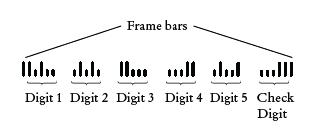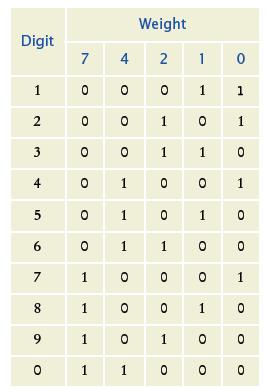For faster sorting of letters, the U.S. Postal Service encourages companies that send large volumes of mail
Question:
For faster sorting of letters, the U.S. Postal Service encourages companies that send large volumes of mail to use a bar code denoting the ZIP code (see Figure 8).
The encoding scheme for a five-digit ZIP code is shown in Figure 9. There are full-height frame bars on each side. The five encoded digits are followed by a check digit, which is com puted as follows: Add up all digits, and choose the check digit to make the sum a multiple of 10. For example, the sum of the digits in the ZIP code 95014 is 19, so the check digit is 1 to make the sum equal to 20.
Figure 8

Figure 9

Each digit of the ZIP code, and the check digit, is encoded according to the table at right, where 0 denotes a half bar and 1 a full bar. Note that they represent all combinations of two full and three half bars. The digit can be computed easily from the bar code using the column weights 7, 4, 2, 1, 0. For example, 01100 is 0 × 7 + 1 × 4 + 1 × 2 + 0 × 1 + 0 × 0 = 6 The only exception is 0, which would yield 11 according to the weight formula.

Write a program that asks the user for a ZIP code and prints the bar code. Use : for half bars, | for full bars. For example, 95014 becomes ||:|:::|:|:||::::::||:|::|:::|||
(Alternatively, write a graphical application that draws real bars.)
Your program should also be able to carry out the opposite conversion:
Translate bars into their ZIP code, reporting any errors in the input format or a mismatch of the digits.
Step by Step Answer:






